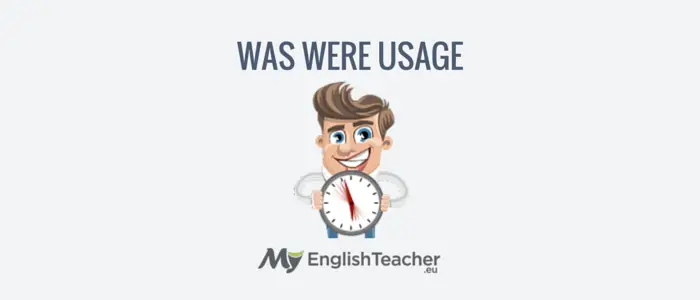
THE USAGE OF ‘WAS’ AND ‘WERE’ WITH EXAMPLES
Let’s start from the beginning.
These are the past simple forms of the verb ‘to be’. Generally, ‘was’ is used with singular pronouns (one subject), and ‘were’ is used with plural pronouns (more than one subject), but the pronoun ‘you’ is an exception!
WAS is usually used with the pronouns ‘I’, ‘she’, ‘he’, and ‘it’.
WERE is usually used with pronouns ‘you’, ‘we’, and ‘they’.
(See the information just before and after ‘USE 2’ below, for more information about the use of the pronouns ‘you’ and ‘I’.)
[Tweet “WAS is usually used with the pronouns ‘I’, ‘she’, ‘he’, and ‘it’. “]
USE 1:
PAST SIMPLE
Some basic sentence examples:
- I was married for 5 years.
- She was unwell last week.
- It was not my fault!
- We were worried about the test results.
- They were busy working all day yesterday.
- You were supposed to help me.
However, there are exceptions to this rule!
Firstly, as I mentioned before, even though ‘you’ is a singular pronoun it is used with WERE.
- You were asleep when he rang.
- Where were you yesterday?
- Whom were you talking to?
[Tweet “WERE is usually used with pronouns ‘you’, ‘we’, and ‘they’.”]
USE 2:
PAST SUBJUNCTIVE AS A CONDITIONAL
Secondly, the pronoun ‘I’ can be used with WERE as a conditional as well as with WAS. WERE is the past subjunctive of the present verb ‘to be’, meaning it expresses hope, possibility or supposition rather than stating a fact.
- If I were you, I wouldn’t touch that.
(I’m not you, it’s hypothetical – used for the present or future)
- If I were a multi-billionaire, I would rid the world of poverty.
(I’m not a multi-billionaire, it’s hypothetical – used for the present or future)
- If I were in his shoes, I would accept their offer.
(I’m not him or in his position, it’s hypothetical – used for the present and future)
- If I was rude to you yesterday, I’m very sorry.
(The condition is unclear, but it is presumed to have been true in the past)
- If I was annoying you last night, I’m sorry. I was in a bad mood.
(The condition is unclear, but it is presumed to have been true in the past)
- If I was healthier, I probably would have been able to win the race.
(The condition is unclear, but it is presumed to have been a possibility of being true in the past)
Read more:
If I Was or If I Were?
PAST CONTINUOUS / PAST SIMPLE
Remember that in Past Simple, a specific time is used to show when an action began or finished. In Past Continuous (Progressive), a specific time only interrupts the action.
USE 3:
INTERRUPTED ACTION IN THE PAST
[subject 1 + WAS/WERE + verb+ing + WHEN + subject 2 + past simple verb]
Use Past Continuous to indicate when a longer action in the past was interrupted, usually by a shorter action that occurs (Past Simple).
Here are some examples:
- She was studying when he called.
- He was cooking when the phone rang.
- They were shopping when they heard an explosion.
- We were dancing when the power went out.
- I was listening to music when the doorbell rang.
Read more:
How to use IS, WAS, THAT, THE!
USE 4:
SPECIFIC TIME AS AN INTERRUPTION
Similar to USE 1 above, however you can use a specific time as an interruption.
- At 3am last night, I was studying.
- Last night at 8pm, we were watching a movie.
- Yesterday at this time, I was sitting in my office.
USE 5:
DESCRIBING PARALLEL ACTIONS
You can use the Past Continuous to describe two parallel actions in one sentence. It expresses the idea that they were happening at the same time.
- I was cooking while he was playing with the baby.
- While Eleanor was studying, Toby was cooking a meal for them.
- I wasn’t paying attention when he was talking to me, so I don’t remember everything he said.
Read more:
Subjunctive “I Wish I Were” [Infographic]
USE 6:
A SERIES OF PARALLEL ACTIONS
A series of parallel actions can be used to describe the atmosphere at a particular time in the past.
- When I walked into my house, my husband was watching TV, the baby was crying, my son was playing computer games, and the dog was barking in the garden!
- When I stepped into the office, my boss was shouting at someone on the phone, his secretary was running towards his office, my assistant was printing a document, and all the telephones were constantly ringing!
USE 7:
REACTION OF A SUBJECT
[Subject + WAS/WERE + adjective + at/by/with + noun]
Used to show the reaction of a subject towards a noun.
- I was amazed at how clean the house was!
- We were surprised by their eagerness to help us.
- She was very happy with her new car.
USE 8:
ADVERBS OF FREQUENCY
The Past Continuous is used with adverbs of frequency such as ‘always’ or ‘constantly’ to express that something happened often in the past. Note: This does not apply to all the adverbs of time.
[Subject + WAS/WERE + adverb of time + verb+ing]
- He was always buying me flowers.
- She was constantly talking throughout my lessons.
- They were always sitting next to each other in class.
- She was usually sitting in the garden on a Friday.
- I was continuously exceeding expectations.
Read more:
How To Use The Passive Voice With Helpful Examples
USE 9:
WHILE VS WHEN
Dependent clauses are groups of words which have meaning but aren’t complete sentences. Some clauses can start with the word ‘when’ and others can start with the word ‘while’ (Note: This does not apply to all dependent clauses). When you talk about things in the past, ‘when’ is usually followed by the Past Simple verb, whereas ‘while is followed by the Past Continuous verb. They have similar meanings but
When you talk about things in the past, ‘when’ is usually followed by the Past Simple verb, whereas ‘while is followed by the Past Continuous verb. They have similar meanings but emphasize different parts of a sentence.
Here are some examples:
- I was studying when the doorbell rang.
- While I was studying, the doorbell rang.
- She was cooking when her friends arrived.
- While she was cooking, her friends arrived.
USE 10:
ADVERBS OF TIME PLACEMENT
Adverbs of time can be added to sentences in the Past Continuous tense. You can use adverbs such as always, never, ever, only, still, just, etc. Here are some examples to show you the placement for adverbs:
- Weren’t you ever listening to what I said?
- You were never listening to anything I said.
- Was she always telling you off?
- She was always telling you off.
- He was still shouting as she walked away.
- Was he still shouting as she walked away?
USE 11:
ACTIVE AND PASSIVE
Sentences can be active or passive. Most sentences are active, where the subject is doing the action and the object is receiving the action. The subject and object can be swapped around to change a sentence from active to passive.
Active – The professor was teaching his students.
Passive – The students were being taught by the professor.
Active – Jenny was making tea for her friends.
Passive – Tea was being made by Jenny for her friends.
Active – Her brother was hugging her.
Passive – She was being hugged by her brother.
USE 12:
USING A SPECIFIC PERIOD OF TIME
You can describe the state of a noun at a particular time in the past.
[Subject + WAS/WERE + time period]
- I was only 16 when I started working full-time.
- Why were you being horrible to me last week?
- I was just a paperboy before I became CEO of the New York Times.
Read more:
When to Use THIS and THAT in English?


























